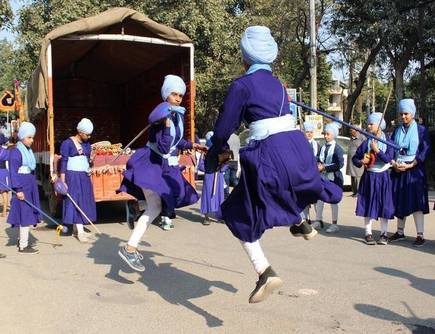Bodo Accord
Why in News
Recently, the central government, the Assam government and the Bodo groups, including all factions of the militant National Democratic Front of Bodoland (NDFB), signed an agreement to redraw and rename the Bodoland Territorial Area District (BTAD) as the Bodoland Territorial Region (BTR), in Assam.
- BTAD is spread over four districts of Kokrajhar, Chirang, Baksa and Udalguri.
- The BTAD and other areas mentioned under the Sixth Schedule of the Constitution have been exempted from the Citizenship (Amendment) Act (CAA), 2019.
Key Points
- Bodoland Territorial Region would include the villages which are dominated by Bodos but are outside BTAD presently. Villages with non-Bodo population would be excluded from it.
- A committee will be formed to decide the exclusion and inclusion of new areas. Subsequently, the total number of Assembly seats will go up to 60, from the existing 40.
- Both the representatives of the All Bodo Students Union (ABSU) and of Bodoland Territorial Council (BTC) will be present in the committee.
- Bodo-Kachari Welfare Council will be set up for focused development of Bodo villages outside BTAD.
- Bodos living in the hills would be conferred a Scheduled Hill Tribe status.
- Bodo language with Devanagari script would be the associate official language for the entire Assam.
- However, the agreement has not addressed the issue of “citizenship or work permit” for non-domiciles in the BTAD yet.
- Around 1500 cadres of NDFB will be rehabilitated and assimilated by the Central and the state governments.
- The criminal cases registered against factions of NDFB members for non-heinous crimes shall be withdrawn and the cases of heinous crimes will be reviewed.
- Comprehensive solutions have been made to redress the grievances of the people.
- Families of the people killed during the Bodo movement would get ₹5 lakh each.
- A Special Development Package of ₹1500 crore would be given by the Centre to undertake specific projects for the development of Bodo areas.
Benefits
- The accord will successfully bring together leading stakeholders under one framework.
- People previously associated with armed resistance groups will enter the mainstream and contribute to the nation’s progress.
- It will further protect and popularise the unique culture of the Bodo people and will give them access to a wide range of development-oriented initiatives.
- It will bring peace, harmony and togetherness in the people of Assam.
Background
- Bodos are the single largest community among the notified Scheduled Tribes in Assam. Bodos are a part of Bodo-Kachari and constitute about 5-6% of Assam’s population.
- The first organised demand for a Bodo state came in 1967-68.
- The Assam Accord of 1985, gave rise to Bodo aspirations and in 1987, ABSU revived the Bodo statehood demand.
- Bodo Security Force which arose in 1986 as an armed group renamed itself NDFB, and later split into factions.
- The first Bodo accord was signed with the ABSU in 1993. It led to the creation of the Bodoland Autonomous Council (BAC) with some limited political powers.
- In 2003, the second Bodo Accord was signed by the extremist group Bodo Liberation Tiger Force (BLTF), the Centre and the state. This led to the creation of BTC, which is an autonomous body under the Sixth Schedule of the Constitution.
E- Retailers to Collect Plastic Waste
Why in news
The Central Pollution Control Board (CPCB) has told the National Green Tribunal (NGT) that e-commerce giants Amazon and Flipkart need to fulfil their extended producer responsibility under the Plastic Waste Management Rules, 2016.
- According to the Plastic Waste Management Rules, 2016 “Primary responsibility for collection of used multi-layered plastic sachet or pouches or packaging is of producers, importers and brand owners who introduce the products in the market”.
- They need to establish a system for collecting back the plastic waste generated due to the packaging of their products.
Extended Producer Responsibility (EPR)
- EPR is a policy approach under which producers are given a significant responsibility – financial and/or physical – for the treatment or disposal of post-consumer products.
- Assigning such responsibility could in principle provide incentives to prevent wastes at the source, promote product design for the environment and support the achievement of public recycling and materials management goals.
Plastic Waste Management Rules
- These rules were framed in 2016 which extended the responsibility to collect waste generated from the products to their producers (i.e persons engaged in the manufacture, or import of carrying bags, multi-layered packaging and sheets or like and the persons using these for packaging or wrapping their products) and brand owners.
- They have to approach local bodies for the formulation of plan/system for the plastic waste management within the prescribed time frame.
- The rules have been extended to villages as well. Earlier, it was limited to municipal districts.
- Central Pollution Control Board (CPCB) has been mandated to formulate the guidelines for thermoset plastic (plastic difficult to recycle).
- Earlier, there was no specific provision for such type of plastic.
- Manufacturing and use of non-recyclable multi-layered plastic are to be phased in two years, i.e. by 2018.
- The 2016 rules were amended in 2018, laying emphasis on the phasing out of Multilayered Plastic (MLP), which are "non-recyclable, or non-energy recoverable, or with no alternate use."
- The amended Rules also prescribe a central registration system for the registration of the producer/importer/brand owner.
- The amendment provided that registration should be automated and take into account ease of doing business for producers, recyclers and manufacturers.
- While a national registry has been prescribed for producers with a presence in more than two states, a state-level registration has been prescribed for smaller producers/brand owners operating within one or two states.
Central Pollution Control Board
- The Central Pollution Control Board (CPCB) of India is a statutory organisation under the Ministry of Environment, Forest and Climate Change.
- It was established in 1974 under the Water (Prevention and Control of Pollution) Act, 1974.
- The CPCB is also entrusted with the powers and functions under the Air (Prevention and Control of Pollution) Act, 1981.
Way Forward
- Plastic packaging constitutes more than 40% of the total plastic waste generated in India and it is important that a direction is issued to the e-retailers that they should stop using plastic packaging materials and shift to environment-friendly packaging materials and shift to environment-friendly packaging option.
Guidelines to Monitor Sand Mining
Why in News
For the first time, the Ministry of Environment, Forests and Climate Change (MoEFCC) has released guidelines to monitor and check illegal sand mining in the country.
- At present, the Sustainable Sand Management Guidelines (SSMG), 2016 focus on the management of sand mining, but there was a need to have guidelines for effective enforcement of regulatory provisions and their monitoring.
- The 2020 guidelines are to be enforced simultaneously with the SSMG, 2016, in case of conflict, the new set will hold legal precedence.
Key Points
- Background
- The Mines and Minerals (Development and Regulation) Act, 1957 has empowered state governments to make rules to prevent illegal mining, transportation and storage of minerals.
- However, there was a large number of illegal mining cases in the country and in some cases, many of the officers lost their lives while executing their duties to curb illegal mining.
- Illegal and uncontrolled illegal mining also leads to loss of revenue to the State and degradation of the environment.
- Constitutional/ Legal Framework of Mining Sector in India
- The entry at serial No. 23 of List II (State List) to the Constitution of India mandates the state government to own the minerals located within their boundaries.
- The entry at serial No. 54 of List I (Central List) mandates the central government to own the minerals within the exclusive economic zone of India (EEZ). In pursuance to this Mines & Minerals (Development and Regulation) (MMDR) Act of 1957 was framed.
- Also, the Central Government notifies certain minerals as 'minor' minerals from time to time for which the absolute powers for deciding on procedures of seeking applications for and granting mineral concessions, fixing rates of royalty, dead rent, and power to revise orders rest only with the State Government.
- Example of minor minerals include building stones, gravel, ordinary clay, ordinary sand.
- For minerals specified in the First Schedule to the Mines and Minerals (Development and Regulation) Act, 1957 approval of the Central Government is necessary.
- Schedule I contains minerals such as coal and lignite, minerals of the “rare earths” group containing Uranium and Thorium.
- Enforcement and Monitoring Guidelines for Sand Mining 2020
- Source to Destination Monitoring: The new set of guidelines focuses on the effective monitoring of sand mining from the identification of sand mineral sources to its dispatch and end-use by consumers and the general public and look at a uniform protocol for the whole country.
- Constantly monitor mining with drones and night surveillance of mining activity through night-vision drones.
- Audits: States to carry out river audits, put detailed survey reports of all mining areas in the public domain.
- Transparency: Online sales and purchase of sand and other riverbed materials (RBM) for transparency in the process.
- Enforcement: It gives directions to states to set up dedicated task forces at district levels.
- In cases where rivers become district boundaries or state boundaries, the districts or states sharing the boundary shall constitute the combined task force for monitoring of mined materials, mining activity and participate in the preparation of District Survey Reports (DSR) by providing appropriate inputs.
- Sustainability: Conduct replenishment study for river bed sand in order to nullify the adverse impacts arising due to excessive sand extraction.
- No riverbed mining will be allowed during the monsoon.
- Source to Destination Monitoring: The new set of guidelines focuses on the effective monitoring of sand mining from the identification of sand mineral sources to its dispatch and end-use by consumers and the general public and look at a uniform protocol for the whole country.
Procedure for Comprehensive DSRs
- While the Sustainable Sand Mining Guidelines, 2016, require the preparation of District Survey Reports (DSR), which is an important initial step before grant of mining lease, the government has found that the DSRs carried out by state and district administrations are often not comprehensive enough, allowing space for illegal mining.
- The new guidelines, therefore, list a detailed procedure of how the DSRs are to be made, including the development of an inventory, for the first time, of river bed material and other sand sources in the district.
Draft Bill to Raise Upper Limit for Abortion
Why in News
The Union Cabinet has approved changes to the Medical Termination of Pregnancy (MTP) Act, 1971 in order to increase the upper limit for termination of a pregnancy from 20 weeks to 24 weeks.
Present Abortion Law
- The Medical Termination of Pregnancy (MTP) Act, 1971 provides for termination of pregnancy only up to 20 weeks. If an unwanted pregnancy has proceeded beyond 20 weeks, women have to approach a medical board and Courts to seek permission for termination, which is extremely difficult and cumbersome process.
- According to Section 3 (2) of the MTP Act, 1971 a pregnancy may be terminated by a registered medical practitioner-
- Where the length of the pregnancy does not exceed twelve weeks, or
- Where the length of the pregnancy exceeds twelve weeks but does not exceed twenty weeks. In this case, the abortion will take place, if not less than two registered medical practitioners are of opinion, that the continuance of the pregnancy would involve a risk to the life of the pregnant woman (her physical or mental health); or there is a substantial risk that if the child were born, it would suffer from some physical or mental abnormalities to be seriously handicapped.
- Issue: The law does not accommodate non-medical concerns over the economic costs of raising a child, effects on career decisions, or any other personal considerations.
- The law says, for minors- written consent from guardian is required, and
- The unmarried women cannot cite contraceptive failure as a reason for abortion.
Provisions of Proposed Bill
- Requirement of opinion of one registered medical practitioner (instead of two or more) for termination of pregnancy up to 20 weeks of gestation (time between conception and birth).
- Requirement of opinion of two registered medical practitioners for termination of pregnancy of 20 to 24 weeks.
- Increase the upper gestation limit (for abortion) from 20 to 24 weeks for survivors of rape, victims of incest (human sexual activity between family members or close relatives) and other vulnerable women, including minor girls.
- For unmarried women, the Bill seeks to relax the contraceptive-failure condition. Earlier “only married woman or her husband” were allowed to medically terminate the pregnancy, but the Bill proposes the same for “any woman or her partner”.
Conclusion
- The Bill if passed will provide greater reproductive rights to women as abortion is considered an important aspect of the reproductive health of women. Deaths and injuries from unsafe abortions are largely preventable, provided services are performed legally by trained practitioners.
Addition to Ramsar Sites
Why in News
India has added 10 more wetlands to the sites protected by the Ramsar Convention.
- These are:
- Maharashtra: Nandur (state’s first).
- Punjab: Keshopur-Miani, Beas Conservation Reserve and Nangal.
- Uttar Pradesh: Nawabganj, Parvati Agra, Saman, Samaspur, Sandi and Sarsai Nawar.
- The other 27 Ramsar sites are in Rajasthan, Kerala, Odisha, Madhya Pradesh, Himachal Pradesh, Assam, West Bengal, Jammu and Kashmir, Andhra Pradesh, Manipur, Gujarat, Tamil Nadu and Tripura.
Key Points
- This addition will help in achieving India’s ambition mission ‘Nal se Jal’ which aims to provide piped water connection to every household by 2024.
- Wetlands provide a wide range of important resources and ecosystem services such as food, water, fibre, groundwater recharge, water purification, flood moderation, erosion control and climate regulation.
Ramsar Convention
- It was signed in 1971 in the Iranian city of Ramsar and is one of the oldest inter-governmental accord for preserving the ecological character of wetlands.
- It is also known as the Convention on Wetlands.
- Its aim is to develop and maintain an international network of wetlands which are important for the conservation of global biological diversity and for sustaining human life through the maintenance of their ecosystem components, processes and benefits.
- Wetlands declared as Ramsar sites are protected under strict guidelines of the convention.
Montreux Record
- Montreux Record under the Ramsar Convention is a register of wetland sites on the List of Wetlands of International Importance where changes in ecological character have occurred, are occurring, or are likely to occur as a result of technological developments, pollution or other human interference.
- It is maintained as part of the Ramsar List.
- Currently, two wetlands of India are in Montreux record: Keoladeo National Park (Rajasthan) and Loktak Lake (Manipur).
- Chilika lake (Odisha) was placed in the record but was later removed from it.
Introduction of African Cheetah in India
Why in News
- Recently, the Supreme Court has lifted its seven-year-long stay on a proposal to introduce African Cheetahs from Namibia into the Indian habitat.
- Court has now allowed to initiate the re-introduction of foreign Cheetahs into the Palpur Kuno sanctuary in Madhya Pradesh on an experimental basis. In 1952, the Asiatic Cheetah was officially declared extinct from India.
| Sr. No. | Parameter | African Cheetah | Asiatic Cheetah |
| 1. | IUCN status | Vulnerable | Critically Endangered. |
| 2. | CITES status | Appendix-I of the List. This List comprises of migratory species that have been assessed as being in danger of extinction throughout all or a significant portion of their range. | Appendix-I of the List. |
| 3. | Habitat | Around 6,500-7,000 African cheetahs present in the wild. | 40-50 found only in Iran. |
| 4. | Physical Characteristics | Bigger in size as compared to Asiatic Cheetah. | Smaller and paler than the African cheetah. Has more fur, a smaller head and a longer neck. Usually have red eyes and they have a more cat-like appearance. |
| 5. | Image |  |
 |
Note:
- According to the United Nations, Cheetahs are listed as “Vulnerable” by the International Union for Conservation of Nature (IUCN) Red List of Threatened Species, but a recent study revealed the decline in its significant population. Hence, scientists are demanding for cheetahs to be uplisted to “Endangered” category.
- In North Africa and Asia, they are considered to be “Critically Endangered.”
Gatka Martial Art
Key Points
- Gatka is a traditional martial art form associated with the Sikh gurus.
- It imbibes sword and sticks fighting skills and self-control.
- Gatka is believed to have originated when the 6th Sikh Guru Hargobind adopted ‘Kirpan’ for self-defence during the Mughal era.
- A style of stick fighting between two or more practitioners, Gatka is a toned-down version of the deadlier Shastar Vidya. The sharp swords of Shastar Vidya have been replaced by wooden sticks (soti) and shields (farri) in Gatka.
- It is considered as a battle technique.

- 10th Guru Gobind Singh made it compulsory for everyone to use the weapons for self-defence.
- It was earlier confined to gurudwaras, nagar kirtans and akharas, but now it finds presence in the sports category after the formation of the Gatka Federation of India (GFI) in 2008.
- Today, it is used to showcase self-defence and fighting skills and is open to people of all faiths and communities.
